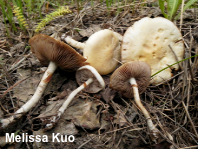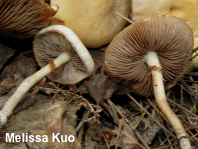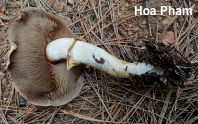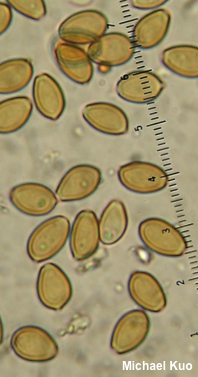| Major Groups > Gilled Mushrooms > Dark-Spored > Agrocybe & Cyclocybe > Agrocybe biological species II |

|
Agrocybe biological species II [ Basidiomycota > Agaricales > Strophariaceae > Agrocybe . . . ] by Michael Kuo This western North American mushroom is a distinct biological species in the cluster of species centered around Agrocybe praecox. Like other species in the group, Agrocybe biological species II is a medium-sized, pale brown mushroom featuring a brown spore print and a partial veil that usually forms a fragile ring on the stem. Agrocybe biological species II appears in woodland settings—usually in riparian ecosystems—from the Rocky Mountains westward. Similar species are best separated by range and ecology. Agrocybe acericola appears in hardwood forests east of the Rocky Mountains, while Agrocybe praecox is generally found in woodchips in urban settings, or in disturbed ground locations. Research by Flynn and Miller (1990) separated these species through mating studies, along with another woodland species known only from Denmark. The researchers noted that the species appeared to be fairly variable in their physical features and were morphologically indistinguishable. Thanks to Hoa Pham for documenting, collecting, and preserving Agrocybe biological species II for study; her collection is deposited in The Herbarium of Michael Kuo. Description: Ecology: Saprobic; growing alone, scattered, or gregariously in woods, usually in riparian ecosystems, under hardwoods or conifers; summer; widely distributed in the United States from the Rocky Mountains westward. The illustrated and described collections are from Colorado. Cap: 3–8 cm; convex at first, becoming broadly convex, broadly bell-shaped, or nearly flat; dry; bald; pale yellow-brown to dull brownish yellow or nearly white; the margin sometimes hung with a few white partial veil fragments. Gills: Narrowly attached to the stem; close; short-gills frequent; whitish at first, becoming dull brown; at first covered by a white partial veil. Stem: 5–10 cm long and 4–11 mm thick; more or less equal; bald; whitish to brownish; with a collapsing, thin, ephemeral, white ring that develops a brown upper edge; basal mycelium white; base attached to white rhizomorphs. Flesh: White; unchanging when sliced. Odor and Taste: Mealy. Chemical Reactions: KOH on cap surface negative to dull orangish. Spore Print: Brown. Microscopic Features: Spores 8–12 x 5–7.5 µm; more or less ellipsoid, with one end flattened for a 1–1.5 µm pore; smooth; thick-walled; brownish golden in KOH. Basidia 22–28 x 7–8 µm; subclavate; 4-sterigmate. Cheilocystidia 30–40 x 7.5–15 µm; clavate or subclavate; smooth; thin-walled; hyaline in KOH. Pleurocystidia 45–65 x 15–25 µm; utriform, often with the top portion swollen a bit; smooth; thin-walled; hyaline in KOH. Pileipellis hymeniform; terminal elements 5–30 µm wide; clavate to pyriform; hyaline in KOH. REFERENCES: Flynn & Miller, 1990. Herb. Kuo 08150706, 07231303, 06032001. This site contains no information about the edibility or toxicity of mushrooms. |
© MushroomExpert.Com |
|
Cite this page as: Kuo, M. (2021, February). Agrocybe biological species II. Retrieved from the MushroomExpert.Com Web site: http://www.mushroomexpert.com/agrocybe_bs2.html |



